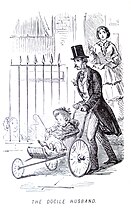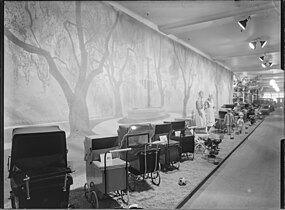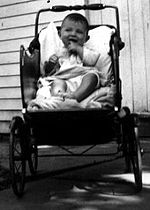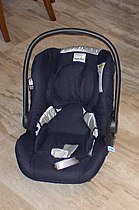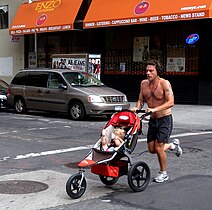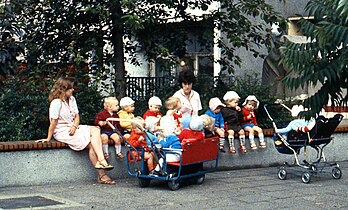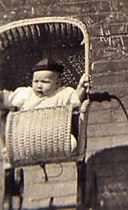
A curb cut (U.S.), curb ramp, depressed curb,dropped kerb (UK), pram ramp, or kerb ramp (Australia) is a solid ramp graded down from the top surface of a sidewalk to the surface of an adjoining street. It is designed primarily for pedestrian usage and commonly found in urban areas where pedestrian activity is expected. In comparison with a conventional curb a curb cut is finished at an intermediate gradient that connects both surfaces, sometimes with tactile paving.
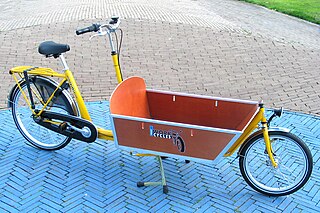
A cargo bike is a human powered vehicle designed and constructed specifically for transporting loads. Cargo bike designs include a cargo area consisting of an open or enclosed box, a flat platform, or a wire basket, usually mounted over one or both wheels, low behind the front wheel, or between parallel wheels at either the front or rear of the vehicle. The frame, drivetrain and wheels must be constructed to handle loads larger than those on an ordinary bicycle.

A child harness is a safety device worn by children when walking with a parent or carer. Child harnesses are most commonly used with toddlers and children of preschool age, though they may also be used with older children, especially if they have special supervisory needs such as ADHD or autism. Various types exist, though all are worn by the child and have a lead (tether) or rein which is held by a parent or caregiver. As child harness designs and purposes have evolved with cultural norms and parenting techniques, they have become subject to common debate.

A baby sling or baby carrier is generally made of soft fabrics that wrap around the chest. They provide comfort and support for the baby and allow the parent or carer to keep their hands free as they go about their everyday tasks.

Babywearing is the practice of wearing or carrying a baby in a sling or in another form of carrier. Babywearing has been practiced for millenia around the world. Babywearing is a form of baby transport which can be used for as long as mutually desired, often until toddlerhood and beyond. In the industrialized world, babywearing has gained popularity in recent decades. Part of the reason for this shift is due to the influence of advocates of attachment parenting.
Owen Finlay Maclaren, MBE was the inventor of the lightweight baby buggy with a collapsible support assembly and founder of the Maclaren company.

Cradleboards are traditional protective baby-carriers used by many indigenous cultures in North America, throughout northern Scandinavia among the Sámi, and in the traditionally nomadic cultures of Central Asia. There is a variety of styles of cradleboard, reflecting the diverse artisan practices of indigenous cultures. Many Central Asian communities and some indigenous communities in North America still use cradleboards.

A bassinet, bassinette, or cradle is a bed specifically for babies from birth to about four months. Bassinets are generally designed to work with fixed legs or caster wheels, while cradles are generally designed to provide a rocking or gliding motion. Bassinets and cradles are distinguished from Moses baskets and carry cots, which are designed to be carried and sit directly on the floor or furniture. After four months, babies are often transferred to a crib or cot. In the United States, however, the bedside sleeper is the prevalent option, since they are generally bigger, recommended up to 6 months, and often used up to a year.

A child safety seat, sometimes called an infant safety seat, child restraint system, child seat, baby seat, car seat, or a booster seat, is a seat designed specifically to protect children from injury or death during vehicle collisions. Most commonly these seats are purchased and installed by car owners, but car manufacturers may integrate them directly into their vehicle's design and generally are required to provide anchors and ensure seat belt compatibility. Many jurisdictions require children defined by age, weight, and/or height to use a government-approved child safety seat when riding in a vehicle. Child safety seats provide passive restraints and must be properly used to be effective. However, research indicates that many child safety restraints are often not installed or used properly. To tackle this negative trend, health officials and child safety experts produce child safety videos to teach proper car seat installation to parents and caregivers.

Maclaren is a manufacturer of baby buggies, strollers and carriers based in England.
The Kind + Jugend Innovation Award is a German design award granted annually to the best overall baby product in the areas of design, safety, user-friendliness, degree of innovation, and quality of workmanship. Particular emphasis is placed on innovation and safety, with past winners displaying unique designs and new technology.
Cybex is a manufacturer of child safety products. The company was founded in 2005 by Martin Pos in Hong Kong as CYBEX Industrial Ltd. It has been owned by the Chinese child safety manufacturer Goodbaby International since 2014. Cybex has locations in Hong Kong, Kulmbach, and Bayreuth and Prague. and sells its products internationally. In 2010 the company had over 100 employees and a profit of 37 million Euros. In 2019 the number of employees rose to 500.
Ann Moore created the hands-free baby carrier called the Snugli and the refined version of it called the Weego.

Silver Cross is an English private limited company and manufacturer of baby transport and other baby-related products, founded in 1877. Based in Skipton, North Yorkshire, United Kingdom, Silver Cross sells baby prams and pushchairs. Its parent company, the Chinese conglomerate Fosun International, owns 87.2 percent of the equity.

Headquartered in Boston, Massachusetts, Evenflo Company, Inc. operates the juvenile travel and home safety businesses with products that include car seats, travel systems, safety gates, high chairs, play yards, stationary activity centers, infant carriers and doorway jumpers. Evenflo Company Inc. has two manufacturing facilities: one in Piqua, Ohio, and one in Tijuana, Mexico.

A travel cot is a bed for use by a baby or young child that collapses or folds into a bag for easy carriage. Travel cots are typically much lighter than a standard cot, with soft sides to provide comfort to the baby when sleeping.

Human-powered land vehicles are land vehicles propelled over ground by human power, The main ways to support the weight of a human-powered land vehicle and its contents above the ground are rolling contact; sliding contact; intermittent contact; no contact at all as with anything carried; or some combination of the above. The main methods of using human power to propel a land vehicle are some kind of drivetrain; pushing laterally against the ground with a wheel, skate, or ski that simultaneously moves forward; by pushing against the ground directly with an appendage opposite to the direction of travel; or by propeller. Human-powered land vehicles can be propelled by persons riding in the vehicle or by persons walking or running and not supported by the vehicle.

Baby furniture refers to furniture created for babies. It is often used to help the parents of the baby keep it safe and comfortable in the home. Before baby furniture, parents would sleep with their children in their own beds, which could be dangerous for the child. Eventually, infant beds started to be built with the child's safety in mind; the intention was to keep the baby from rolling off the bed, so mangers and bassinets were created. Over time, more furniture was created with the infant's safety in mind, and there are several types and functionalities of these. Typical pieces include an infant bed, changing table, high chair, playpen, baby walker, and toy chest. Products, features, and costs vary between countries and have changed over time. Safety is of paramount importance.
Gate check bags are travel bags specially designed for the transportation and storage of car seats and strollers or pushchairs. Generally used for airline travel, they also provide protection from dust when in storage for the occasional user. When used for airline travel the strollers and car seats are placed in gate check bags at the departure gate before boarding. The bags protect strollers and car seats from dirt whilst in the loading or cargo bay as well as from elements such as rain or snow if left on the tarmac.

4moms is an American robotics company specializing in baby products. Founded in March 2005 in Pittsburgh, Pennsylvania, it launched its first product Origami, a self-folding stroller. They are better known as the creator of the momaRoo baby rocker which sold over two million units.






